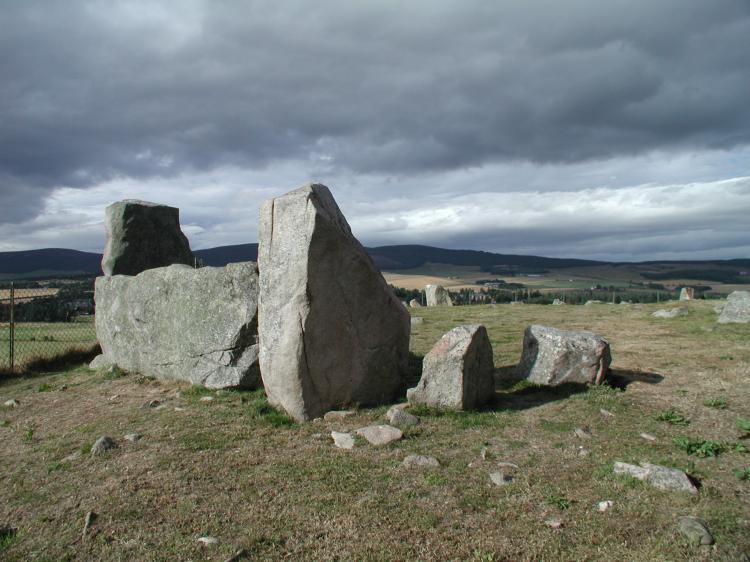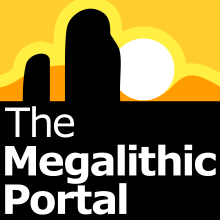<< Books/Products >> Book Review: Great Crowns of Stone, The Recumbent Stone Circles of Scotland
Submitted by Cosmic on Wednesday, 30 November 2011 Page Views: 10612
Neolithic and Bronze AgeCountry: Scotland County: Aberdeenshire Type: Stone CircleInternal Links:

The first chapter controversially reduces the possible 140 plus potential recumbent stone circle sites down to a definitive 71. In the process, geographic outliers in Perth & Kinross and Dumfries & Galloway are dismissed, reasserting the uniqueness of the recumbent circles of Grampian.
Subsequent chapters compare the circles across various features and look at the importance of orientation with its possible archaeoastronomical links. The book is full of photos, pictures and diagrams with a web back-up (see here for a 306 page download of the full Gazetteer and Appendices of the book as a 40MB PDF file). This is now THE book for any recumbent stone circle devotee.
Andy B adds:
Prior to opening this book I had been reading An Archaeology of the Senses: Prehistoric Malta, which encourages interpretation through senses other than sight (review of this book to follow). I felt inspired to write a 'non textual' review.
On opening 'Great Crowns of Stone' for the first time I was overwhelmed by the smell of freshly-cut wood, forest ferns even - but sadly this wonderful aroma has now faded.
The paper has a creamy soft sheen and makes a crisp crump as the large wodges flop back into place into a perfect meniscus of smooth, yet sharp-edged material that it is a pleasure to run your fingers along. The dust-jacket has a beautiful textured feel to it, I have removed this and slipped it on top of the bookcase to keep it in pristine condition - giving me the guilty feeling I am turning into something of a book collector rather than a book reader at times. However this is a book to enjoy as a beautiful object. Undressed the book looks much more serious, with white silk screen print on the beautifully dark textured board.
The sheer quality of printing and binding shines through, I know my copy is not going to fall apart on its travels around Aberdeenshire, unlike a well known multicoloured tome.
But enough of this nonsense (or non-visual-sense).
Just before I do get on to the actual text I should say that the images and graphics are truly impressive both in content and sheer variety.
There are hundreds of archive photos and antiquarian etchings, 'birds-eye' photos, overview maps, site plans and sections, and grading of stone heights. Best of all are the numerous large diagrams with explanatory keys and overlays in colour which make for quick interpretation. As Cosmic said, it is clear that the combined resources of the RCAHMS have fed into this book and a marvellous repository it is.
This is a book which encourages a non-linear reading style, I found myself jumping from section to section and across to the bibliography, where I was impressed at the sheer range of sources quoted. As well as 28 references to the unsurpassed Aubrey Burl, there are quotes from Paul Screeton's Quicksilver Heritage, The Ley Hunter, undergraduate theses, unpublished work by surveyor Douglas Scott, as well as the giants of prehistory that you would expect.
There isn't a specific section dedicated to each recumbent stone circle, instead various aspects are scattered throughout the book, with the name of each circle put in bold for easier recognition. The index is clear and well produced so my flitting was accommodated just fine.
Refreshingly, in what you could call a 'post internet' format, the detailed site gazetteer is moved online (see the link below to the 306 page PDF file which, like the book, is itself packed with graphical content). As with Cosmic, I was particularly interested in Welfare's classification of the circles into 71 thoroughbred examples and 85 'also rans' which are booted into the second division of such monuments (to recklessly mix my metaphors.)
Welfare shows how study of recumbent stone circles is intertwined with the evolution of archaeological thought, covering the origins of ideas about them, from the bizarre (ruined brochs) to the better known. Thought moved on from 1864, when Major-general Sir Henry James ordered for the unhelpful "Druid's..." moniker to be removed from most stone circle listings on OS maps "and within little more than five years the association with druidism had been generally broken".
The author goes on to show how it was discovered that most recumbent stone circles contain some form of cairn, most likely a ring cairn, and brings us up to date with the important excavations by Richard Bradley at Cothiemuir Wood, Tomnaverie and Loanhead of Daviot.
Patterns of loss are investigated, showing how with the best will in the world, our understanding of these sites is still largely informed by a small number of well preserved examples, however bringing the data on disparate sites together in one place can only help future study.
Burl's 'moon hypothesis' is considered in detail, with the idea that each circle was a family shrine, as is the wider archaoastronomical argument which with each piece of new evidence only really seems to hold up in the broadest sense. Reading the conflicting detail of the opposing arguments with all their potential 'special cases' left me rather bewildered about how such a mountain of research could leave so little concrete to show for itself. Welfare is more upbeat towards theories around the use of quartz and representations of 'life giving' properties
While much of the text feels like a 'brain dump' from all the past research, which is useful if a little overwhelming, the author does add a few of his own interpretations, for instance that recumbent stone circles may have "leapt off the page fully formed" rather than as a result of slow diffusionist evolution. "They referenced an idea, and the traits by which this was expressed were carefully chosen and widely understood". "These monuments were ... designed to communicate with the past on behalf of the future".
The contents frequently refer back to the early research, giving much credit to the early investigations of Frederick Coles and the turn-of-the-century photography of James Ritchie.
In bringing together the quality, quantity and breadth of information in an intelligent and visually understandable way, this is one of the very best archaeology books I have experienced - reading is too bland a word to use.
Review by Cosmic and Andy Burnham
 Great Crowns of Stone, The Recumbent Stone Circles of Scotland by Adam Welfare.
Great Crowns of Stone, The Recumbent Stone Circles of Scotland by Adam Welfare.Published by the Royal Commission on the Ancient and Historical Monuments of Scotland (RCAHMS)
Hardback: 280 pages
ISBN: 1902419553
Available from Amazon.co.uk and also available as an ebook from Apple iTunes, see below for details.
See here for the 306 page download of the full Gazetteer and Appendices of the book (40Mb PDF file).
<< Northern Earth issue 128 is out now
Winter Solstice cards and 2012 Ancient Sites Calendars in stock >>



 We would like to know more about this location. Please feel free to add a brief description and any relevant information in your own language.
We would like to know more about this location. Please feel free to add a brief description and any relevant information in your own language. Wir möchten mehr über diese Stätte erfahren. Bitte zögern Sie nicht, eine kurze Beschreibung und relevante Informationen in Deutsch hinzuzufügen.
Wir möchten mehr über diese Stätte erfahren. Bitte zögern Sie nicht, eine kurze Beschreibung und relevante Informationen in Deutsch hinzuzufügen. Nous aimerions en savoir encore un peu sur les lieux. S'il vous plaît n'hesitez pas à ajouter une courte description et tous les renseignements pertinents dans votre propre langue.
Nous aimerions en savoir encore un peu sur les lieux. S'il vous plaît n'hesitez pas à ajouter une courte description et tous les renseignements pertinents dans votre propre langue. Quisieramos informarnos un poco más de las lugares. No dude en añadir una breve descripción y otros datos relevantes en su propio idioma.
Quisieramos informarnos un poco más de las lugares. No dude en añadir una breve descripción y otros datos relevantes en su propio idioma.